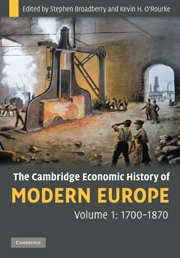Book contents
- Frontmatter
- Contents
- List of figures
- List of tables
- List of contributors
- Preface
- Introduction to Volume 1
- Part I Aggregate growth and cycles
- 1 Understanding growth in Europe, 1700–1870: theory and evidence
- 2 The demographic transition and human capital
- 3 State and private institutions
- 4 Trade and empire
- 5 Business cycles
- Part II Sectoral analysis
- Part III Living standards
- Bibliography
- Index
1 - Understanding growth in Europe, 1700–1870: theory and evidence
Published online by Cambridge University Press: 05 August 2012
- Frontmatter
- Contents
- List of figures
- List of tables
- List of contributors
- Preface
- Introduction to Volume 1
- Part I Aggregate growth and cycles
- 1 Understanding growth in Europe, 1700–1870: theory and evidence
- 2 The demographic transition and human capital
- 3 State and private institutions
- 4 Trade and empire
- 5 Business cycles
- Part II Sectoral analysis
- Part III Living standards
- Bibliography
- Index
Summary
Incomes of ordinary citizens in developed countries today dwarf those enjoyed even by the wealthy elite during most of mankind's history. John Maynard Keynes, with slight incredulity, observed in 1930 that the economic problem of mankind (in Europe and North America at least) had been solved (Keynes, 1930). People no longer go hungry. Clean clothes, shelter, and warmth have gone from luxuries to necessities. By 1870, developments that would eventually deliver this full complement of riches were already in full swing. This chapter summarizes recent research by growth economists on how mankind escaped from a life that was, in the words of Thomas Hobbes, “nasty, brutish, and short.” It contrasts these interpretations with the existing historical evidence and recent findings of economic historians. Four areas are of particular concern – demography, institutions, human capital, and technology. We conclude with suggestions for future research.
Theoretical approaches
In the late 1980s and early 1990s, macroeconomists began to turn their attention from business cycles to the determinants of long-run economic growth. Papers in the endogenous growth literature sought to explain why some countries had grown more rapidly than others. The main period of interest to which these models were applied was the post-war era. They returned to Kuznets's classic argument that current growth rates, when extrapolated backward, implied absurdly low incomes in early modern times and before. Therefore there must have been a long period of stagnation before modern growth started.
- Type
- Chapter
- Information
- The Cambridge Economic History of Modern Europe , pp. 7 - 42Publisher: Cambridge University PressPrint publication year: 2010
- 33
- Cited by

